A1.2- Nucleic Acids
1/25
Earn XP
Name | Mastery | Learn | Test | Matching | Spaced |
|---|
No study sessions yet.
26 Terms
Draw and explain the structure of a nucleotide
a pentose sugar: a simple sugar made up of five carbon atoms
a nitrogenous base: a molecule that contains nitrogen and acts as a base
a phosphate group: a functional group made up of phosphorus and oxygen.
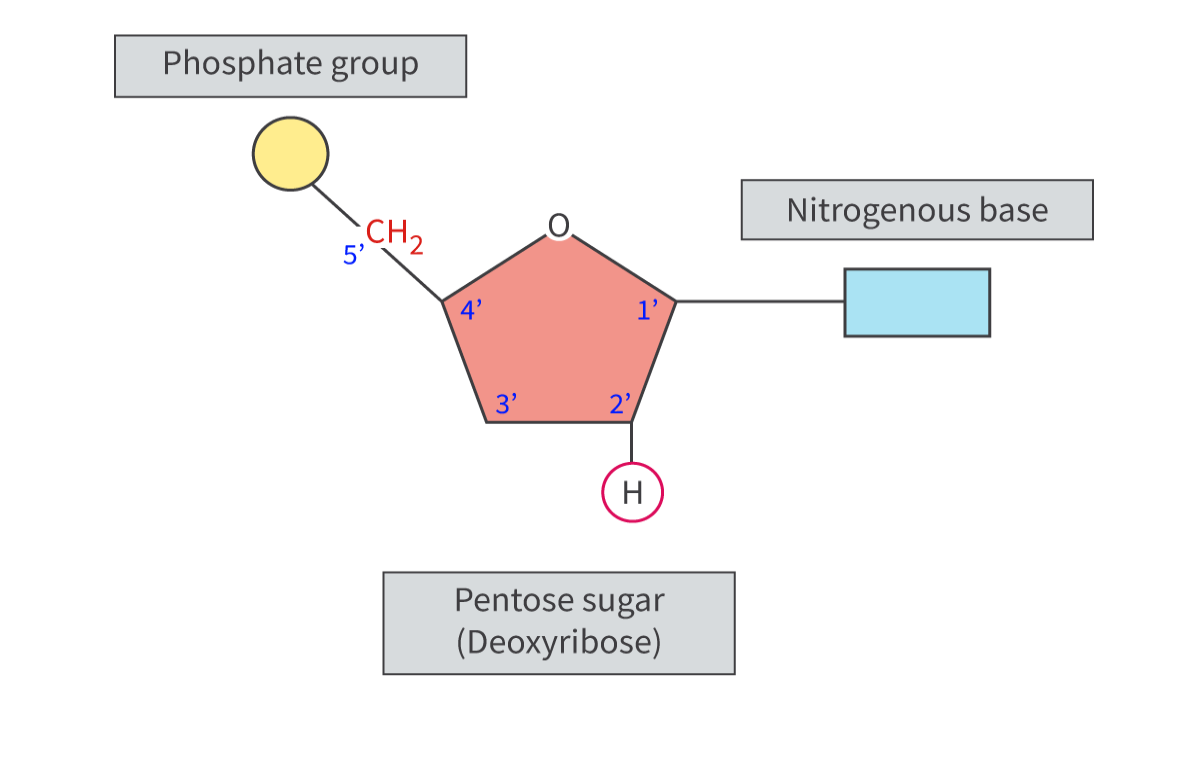
Describe the formation of the sugar−phosphate backbone by nucleotide polymerisation in DNA and RNA.
Nucleotides are connected through phosphodiester bonds formed by a condensation reaction, creating a sugar−phosphate backbone that supports the structure of DNA and RNA.
The backbone runs in a specific direction, from 5′ to 3′, and provides structural support for the molecule, while the nitrogenous bases extend from the backbone to encode genetic information.
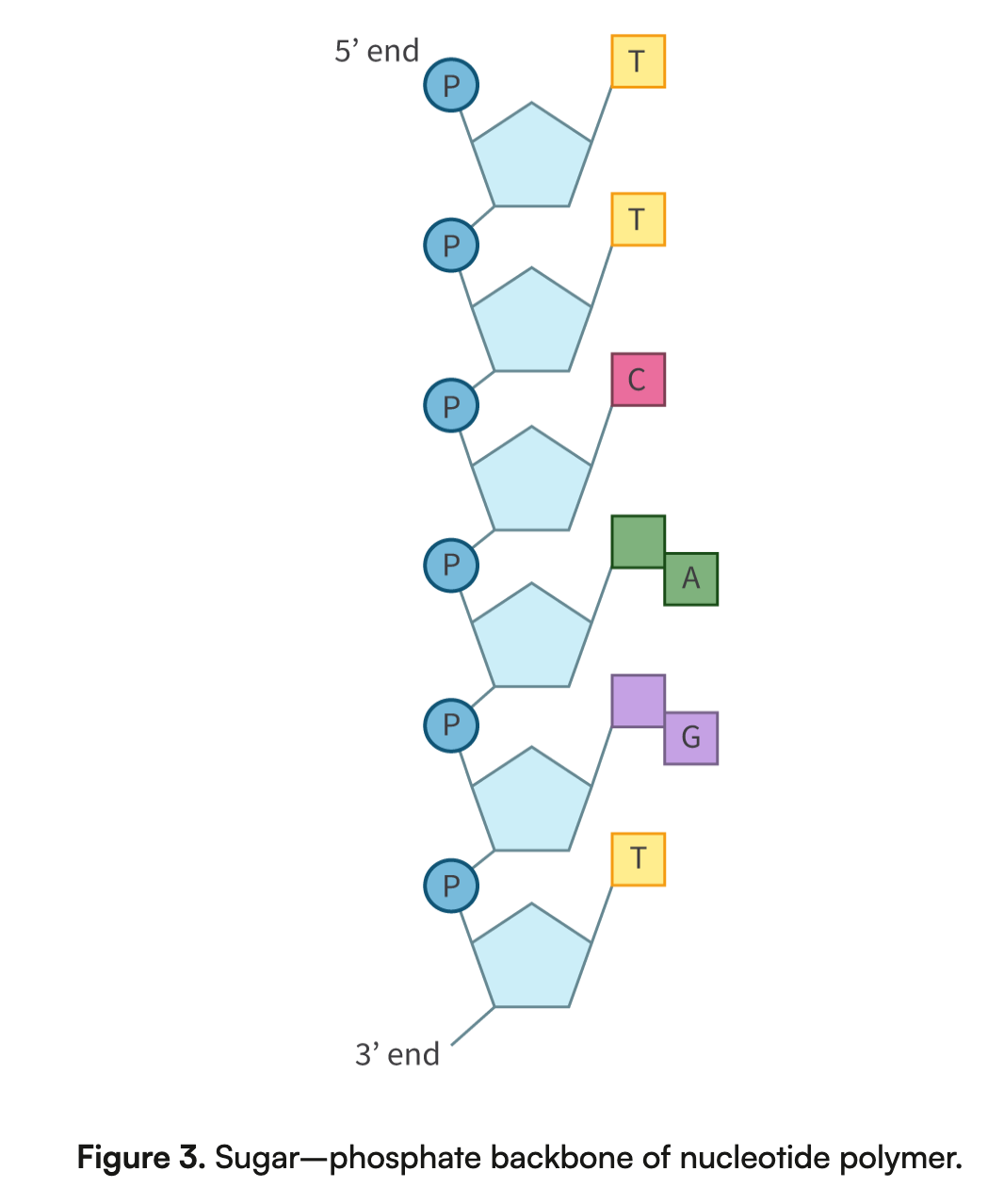
State and compare the nitrogenous bases in each nucleic acid (DNA and RNA).
Thymine (T) is present in DNA but is replaced by Uracil (U) in RNA.
Both DNA and RNA contain Adenine, Cytosine, and Guanine.
Uracil in RNA pairs with Adenine, whereas Thymine in DNA pairs with Adenine.
The nitrogenous bases in DNA are Adenine, Thymine, Cytosine, and Guanine, while in RNA, they are Adenine, Uracil, Cytosine, and Guanine.
Draw and identify diagrams of the structure of single DNA.
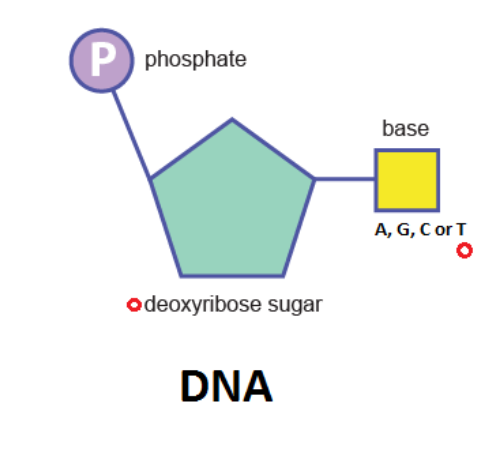
Draw and identify diagrams of the structure of RNA nucleotides.
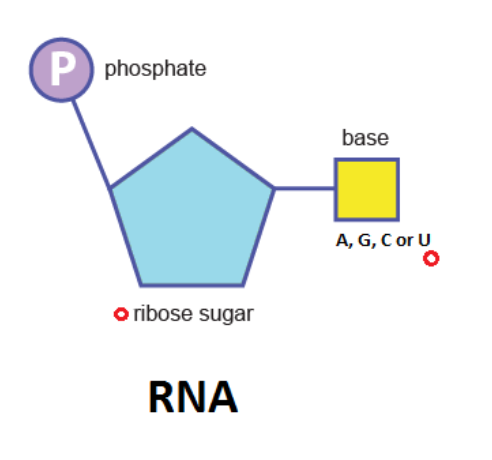
RNA polymer structure
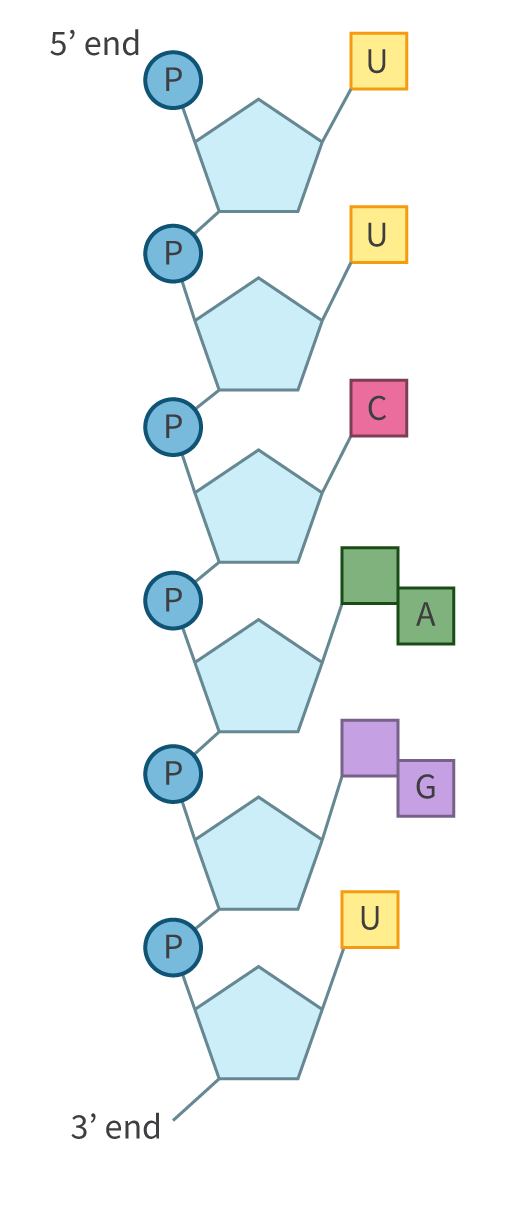
DNA polymer structure
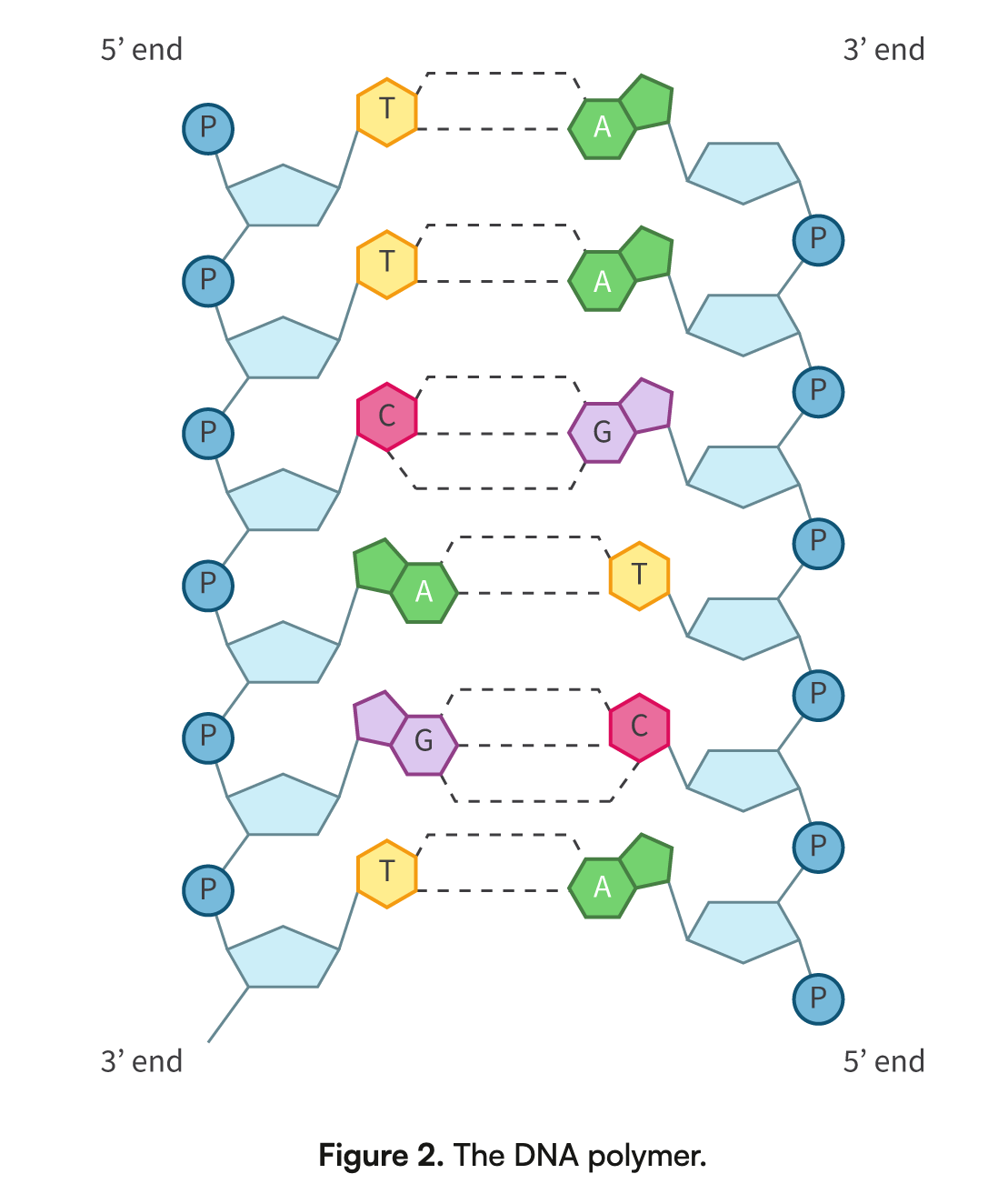
Explain the complementary pairing in a double-strand structure of DNA
Complementary base pairing ensures that A pairs with T and C pairs with G.
Hydrogen bonds hold the base pairs together.
The strands of DNA run antiparallel, meaning one strand runs 5′ to 3′ and the other 3′ to 5′.
The sugar-phosphate backbone is formed by covalent bonds between sugar and phosphate groups in the nucleotides.
Describe the helix shape of a DNA molecule
DNA has a double-stranded helical structure.
The strands are made up of nucleotides connected by phosphate-sugar backbones.
The strands run in antiparallel directions.
The nitrogenous bases form complementary base pairs that are held together by hydrogen bonds.
The helix is a right-handed spiral, and the molecule is stabilized by these base-pair interactions.
Explain the importance of complementary base pairing in allowing genetic information to be replicated and expressed
Complementary base pairing ensures accurate DNA replication and gene expression. During replication, it allows each strand of DNA to serve as a template for creating a matching strand, maintaining genetic consistency. In gene expression, base pairing helps produce complementary mRNA from DNA, which is then used to synthesize the correct protein. This process is essential for maintaining genetic information and ensuring proper cell function.
Explain that diversity of any length of DNA molecule and base sequence is possible, as there is an enormous capacity of DNA for storing data
The diversity of DNA molecules arises from the vast number of possible combinations of the four nitrogenous bases (adenine, thymine, cytosine, and guanine) in any given sequence. This flexibility allows DNA to store an enormous amount of information, with each unique sequence representing different genetic instructions. Even a relatively short DNA molecule can have a vast number of possible variations, contributing to the diversity of genetic information across organisms.
Outline the conservation of the genetic code across all life forms as evidence of universal common ancestry
The genetic code is conserved across all life forms, meaning that the same base sequences in DNA are translated into the same proteins, whether in bacteria, humans, or fungi. This universal use of the genetic code provides evidence for a common ancestry of all living organisms, suggesting that all life shares a single, ancient origin. This conservation supports the idea that life evolved from a common ancestor and that the mechanisms of genetic information storage and protein synthesis are fundamentally the same in all organisms.
Explain the significance of 5'–3' linkage in the sugar-phosphate backbone of DNA for replication, transcription and translation.
The 5'–3' linkage in the sugar-phosphate backbone of DNA is crucial for the processes of replication, transcription, and translation because it ensures the proper directionality and function of these molecular processes.
Replication: During DNA replication, DNA polymerase can only add nucleotides to the 3' end of a growing strand. This directionality ensures that the DNA is replicated accurately, with the enzyme following the template strand in a 3' to 5' direction while synthesizing the new strand in a 5' to 3' direction.
Transcription: In transcription, RNA is synthesized from a DNA template. RNA polymerase reads the DNA template strand in the 3' to 5' direction and synthesizes a complementary RNA strand in the 5' to 3' direction. This directionality ensures that the RNA sequence is accurate and reflects the genetic code.
Translation: In translation, the mRNA (which was synthesized in the 5'–3' direction) is read by ribosomes in the 5' to 3' direction. The ribosome uses this information to assemble amino acids into the correct sequence to form a protein. The correct directionality is essential for producing the correct protein according to the genetic code.
Thus, the 5'–3' directionality in DNA and RNA ensures that these processes are carried out efficiently and with accuracy, preserving genetic information and enabling protein synthesis.
Describe how complementary base pairing stabilises the DNA double helix
Complementary base pairing stabilizes the DNA double helix by ensuring the proper alignment of nitrogenous bases across the two strands, maintaining the integrity and structure of the molecule.
In DNA, adenine (A) always pairs with thymine (T), and guanine (G) pairs with cytosine (C). These pairs are held together by hydrogen bonds: two hydrogen bonds between A and T, and three hydrogen bonds between G and C. This specific pairing ensures that the distance between the two strands of the double helix remains consistent, contributing to the uniform width of the helix.
The stability of the double helix is enhanced by the following factors:
Hydrogen Bonding: The hydrogen bonds between complementary bases provide a moderate but crucial force that holds the two strands together.
Purine-Pyrimidine Pairing: A purine (adenine or guanine) always pairs with a pyrimidine (thymine or cytosine), maintaining an even width of the double helix. This consistency prevents distortion and contributes to the stability of the structure.
Base Pairing Specificity: The specific pairing of bases (A with T and G with C) ensures that the DNA strands can be precisely replicated, with no misalignment, preserving the integrity of genetic information during cell division.
Overall, complementary base pairing ensures that the DNA double helix remains stable, enabling accurate replication and protecting the genetic code.
Explain the structure of a nucleosome
A nucleosome consists of a length of DNA of about 150 base pairs, wrapped around a core of eight histones (which are actually four pairs of four different histones) and a special histone named H1. The nucleosomes are linked, with the DNA strand from one nucleosome flowing directly into the next nucleosome. This section of DNA is called a DNA linker. The overall appearance of DNA in this form has been likened to a ‘string of beads’
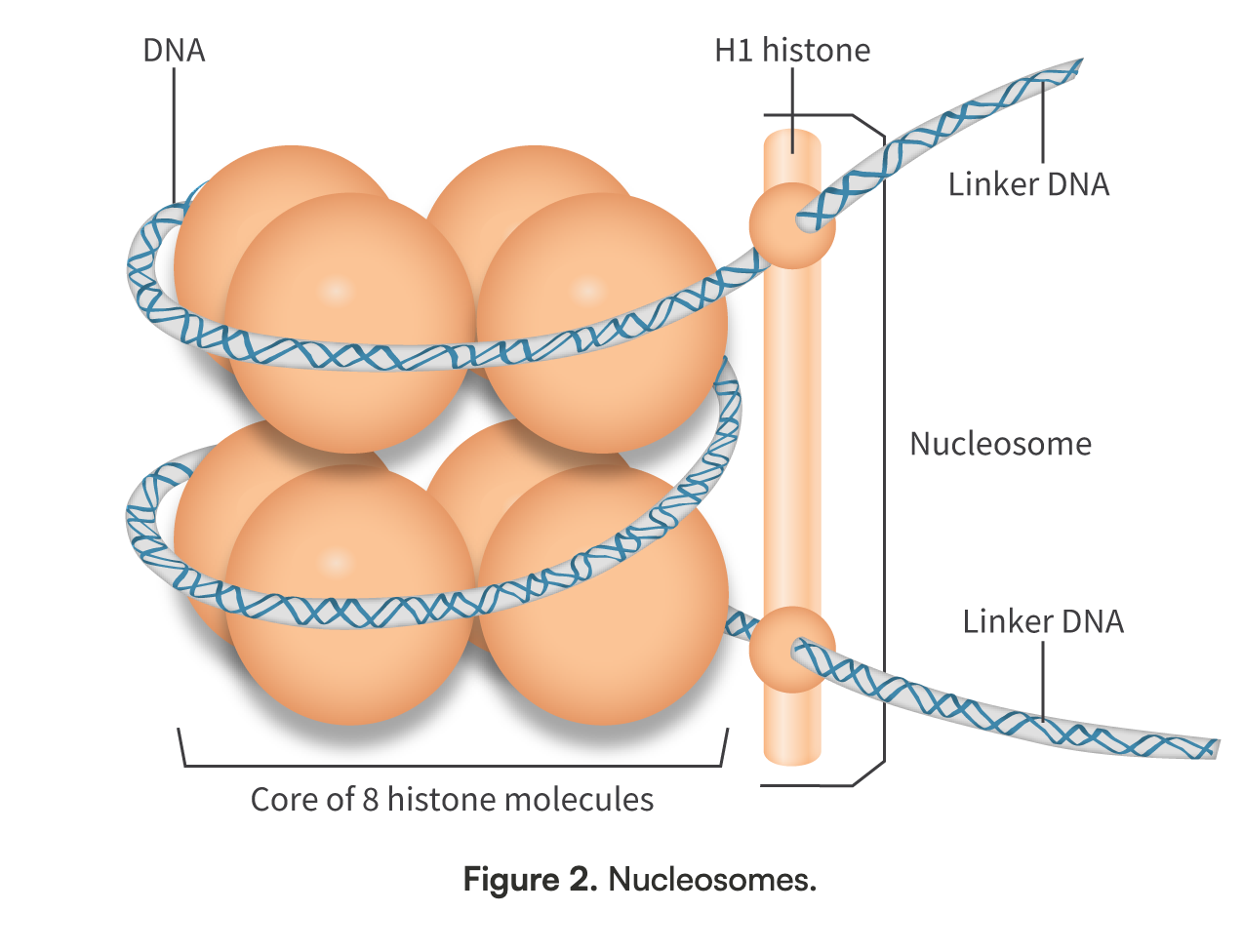
Explain how the findings of the Hershey–Chase experiment support the conclusion that DNA is the genetic material.
The Hershey–Chase experiment demonstrated that DNA, not protein, is the genetic material. By labeling the DNA with radioactive phosphorus and the protein with radioactive sulfur, they found that only the DNA entered bacterial cells during infection, while the protein coat stayed outside. This showed that DNA carries genetic information, as it directed the production of new virus particles inside the bacteria.
Explain how Chargaff’s data on the relative amounts of pyrimidines and purine bases across forms of life provided convincing evidence for complementary base pairing.
Chargaff's data showed that in DNA, the amount of adenine (A) is always equal to thymine (T), and the amount of cytosine (C) is always equal to guanine (G), across different organisms. This finding provided strong evidence for complementary base pairing, as it suggested that A pairs with T and C pairs with G in the DNA structure. This pattern of base pairing supported the double helix model proposed by Watson and Crick.Nucl
Nucleic acids are polymers of repeating units called _______.
nucleotides
There are two types of nucleic acids: deoxyribonucleic acid and _______.
ribonucleic acid
Nucleotides are made up of a _______ base, _______ sugar and ________ group.
nitrogenous, pentose, carboxyl
There are two main types of nitrogenous bases: __________ are bases that contain two rings such as adenine. ____________ are nitrogenous bases that contain one ring such as thymine.
purines, pyrimidines
There are some differences between DNA and RNA. The main difference is that DNA contains ________ sugar, while RNA contains ________. The DNA molecule is ___________, on the other hand, the RNA molecule is _________.
deoxyribose, ribose, double stranded
Complementary ____________ refers to the rule that adenine always binds with thymine and cytosine always binds with guanine in a DNA molecule.
base pairing
[HL] The eukaryotic DNA is associated with proteins called ____________ to form structures called _________ that are important in regulating ________.
histones, nucleosomes, gene expression
[HL] Hershey and Chase discovered that the ___________ is DNA not proteins.
genetic material
[HL] Chargaff concluded that in any form of life the percentage of ____________ is equal to the percentage of thymine and the percentage of cytosine is equal to the percentage of ___________.
adenine, guanine.